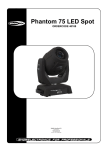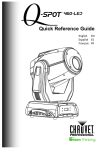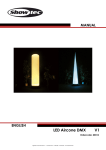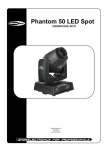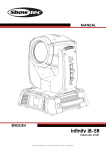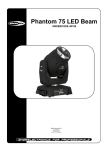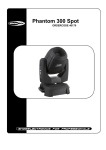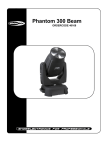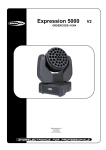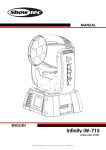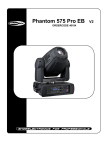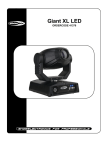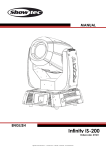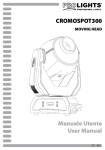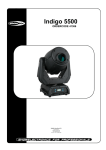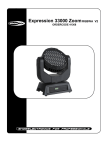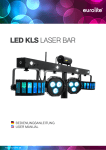Download Indigo 5500
Transcript
Indigo 5500 ORDERCODE 41386 Highlite International B.V. Vestastraat 2 6468 EX Kerkrade The Netherlands Phone: +31 45-5667700 Congratulations! You have bought a great, innovative product from Showtec. The Showtec Indigo 5500 LED brings excitement to any venue. Whether you want simple plug-&-play action or a sophisticated DMX show, this product provides the effect you need. You can rely on Showtec, for more excellent lighting products. We design and manufacture professional light equipment for the entertainment industry. New products are being launched regularly. We work hard to keep you, our customer, satisfied. For more information: [email protected] You can get some of the best quality, best priced products on the market from Showtec. So next time, turn to Showtec for more great lighting equipment. Always get the best -- with Showtec ! Thank you! Showtec Showtec Indigo 5500 LED™ Product Guide Warning ........................................................................................................................................................................................................................ 2 Safety Instructions ............................................................................................................................................................................2 Operating Determinations..............................................................................................................................................................4 Rigging ...............................................................................................................................................................................................4 Return Procedure .............................................................................................................................................................................6 Claims .................................................................................................................................................................................................6 Description of the device ...................................................................................................................................................................................... 7 Overview ...........................................................................................................................................................................................8 Backside.............................................................................................................................................................................................8 Installation ................................................................................................................................................................................................................... 9 Set Up and Operation ............................................................................................................................................................................................. 9 Control Modes ..................................................................................................................................................................................9 One Indigo (Built-in Programs) ..................................................................................................................................................9 One Indigo (Sound-control) ......................................................................................................................................................9 Multiple Indigo‟s (Master/Slave control) .................................................................................................................................9 Multiple Indigo‟s (DMX Control)..............................................................................................................................................10 Fixture Linking ..................................................................................................................................................................................11 Data Cabling ..................................................................................................................................................................................11 Control Panel ..................................................................................................................................................................................12 Control Mode .................................................................................................................................................................................12 DMX Addressing .............................................................................................................................................................................12 Menu Overview ..............................................................................................................................................................................13 Main Menu Options .......................................................................................................................................................................14 1. Address ...................................................................................................................................................................................14 2. Channel Modes/Personalities .............................................................................................................................................14 3. Settings ....................................................................................................................................................................................15 3.1 Performance / Settings Menu ...........................................................................................................................................15 3.2 Range ...................................................................................................................................................................................16 3.3 Default ..................................................................................................................................................................................16 3.4 Send ......................................................................................................................................................................................16 4. Runmode ................................................................................................................................................................................17 4.1 Run .........................................................................................................................................................................................17 4.2. Edit ........................................................................................................................................................................................19 4.3 Send ......................................................................................................................................................................................19 5. Manual ....................................................................................................................................................................................20 5.1 Reset......................................................................................................................................................................................20 5.2 DMX Value ...........................................................................................................................................................................20 6. Service ....................................................................................................................................................................................21 6.1 Access Mode .......................................................................................................................................................................21 6.2 Info version ...........................................................................................................................................................................21 6.3 Display/Send ........................................................................................................................................................................21 DMX Channels ................................................................................................................................................................................22 14 Channels (Person 1).............................................................................................................................................................22 11 Channels (Person 2).............................................................................................................................................................24 Channel settings ..................................................................................................................................................................................26 Maintenance .......................................................................................................................................................................................26 Replacing a Fuse............................................................................................................................................................................27 Replacing a Gobo from the rotating Gobowheel ..................................................................................................................27 Glass Gobo Orientation ................................................................................................................................................................28 Static Gobowheel, Rotating Gobowheel and Colorwheel ..........................................................................................................29 Troubleshooting ....................................................................................................................................................................................................... 29 No Light ............................................................................................................................................................................................29 No Response to DMX .....................................................................................................................................................................30 Product Specification ............................................................................................................................................................................................ 31 1 Warning FOR YOUR OWN SAFETY, PLEASE READ THIS USER MANUAL CAREFULLY BEFORE YOUR INITIAL START-UP! Unpacking Instructions Immediately upon receiving this product, carefully unpack the carton and check the contents to ensure that all parts are present, and have been received in good condition. Notify the dealer immediately and retain packing material for inspection if any parts appear damaged from shipping or the carton itself shows signs of mishandling. Save the carton and all packing materials. In the event that a fixture must be returned to the factory, it is important that the fixture be returned in the original factory box and packing. Your shipment includes: • Showtec Indigo 5500 LED with Volex IEC powercable 1,5m • 2 brackets for truss mounting • Safety cable • User manual LED Expected Lifespan LEDs gradually decline in brightness over time. HEAT is the dominant factor that leads to the acceleration of this decline. Packaged in clusters, LEDs exhibit higher operating temperatures than in ideal or singular optimum conditions. For this reason when all color LEDs are used at their fullest intensity, life of the LEDs is significantly reduced. It is estimated that a viable lifespan of 40,000 to 50,000 hours will be achieved under normal operational conditions. If improving on this lifespan expectancy is of a higher priority, place care in providing for lower operational temperatures. This may include climatic-environmental and the reduction of overall projection intensity. CAUTION! Keep this device away from rain and moisture! Unplug mains lead before opening the housing! Safety Instructions Every person involved with the installation, operation and maintenance of this device has to: be qualified follow the instructions of this manual CAUTION! Be careful with your operations. With a dangerous voltage you can suffer a dangerous electric shock when touching the wires! Before your initial start-up, please make sure that there is no damage caused by transportation. Should there be any, consult your dealer and do not use the device. To maintain perfect condition and to ensure a safe operation, it is absolutely necessary for the user to follow the safety instructions and warning notes written in this manual. Please consider that damages caused by manual modifications to the device are not subject to warranty. This device contains no user-serviceable parts. Refer servicing to qualified technicians only. 2 IMPORTANT: The manufacturer will not accept liability for any resulting damages caused by the nonobservance of this manual or any unauthorized modification to the device. Never let the power-cord come into contact with other cables! Handle the power-cord and all connections with the mains with particular caution! Never remove warning or informative labels from the unit. Never use anything to cover the ground contact. Never lift the fixture by holding it at the projector-head, as the mechanics may be damaged. Always hold the fixture at the transport handles. Never place any material over the lens. Never look directly into the light source. Never leave any cables lying around. Never unscrew the screws of the rotating gobo, as the ball bearing will otherwise be opened. Do not insert objects into air vents. Do not connect this device to a dimmerpack. Do not switch the device on and off in short intervals, as this would reduce the device‟s life. Do not touch the device‟s housing bare-handed during its operation (housing becomes very hot). Allow the fixture to cool for at least 5 minutes before handling. Do not shake the device. Avoid brute force when installing or operating the device. Only use device indoor, avoid contact with water or other liquids. Only operate the fixture after having checked that the housing is firmly closed and all screws are tightly fastened. Only operate the device after having familiarized with its functions. Avoid flames and do not put close to flammable liquids or gases. Always keep case closed while operating. Always allow free air space of at least 50 cm around the unit for ventilation. Always disconnect power from the mains, when device is not used or before cleaning! Only handle the power-cord by the plug. Never pull out the plug by tugging the power-cord. Make sure that the device is not exposed to extreme heat, moisture or dust. Make sure that the available voltage is not higher than stated on the rear panel. Make sure that the power-cord is never crimped or damaged. Check the device and the powercord from time to time. If the lens is obviously damaged, it has to be replaced. So that its functions are not impaired, due to cracks or deep scratches. If device is dropped or struck, disconnect mains power supply immediately. Have a qualified engineer inspect for safety before operating. If the device has been exposed to drastic temperature fluctuation (e.g. after transportation), do not switch it on immediately. The arising condensation water might damage your device. Leave the device switched off until it has reached room temperature. If your Showtec device fails to work properly, discontinue use immediately. Pack the unit securely (preferably in the original packing material), and return it to your Showtec dealer for service. For adult use only. Movinghead must be installed out of the reach of children. Never leave the unit running unattended. Never attempt to bypass the thermostatic switch or fuses. For replacement use fuses of same type and rating only. The user is responsible for correct positioning and operating of the Indigo. The manufacturer will not accept liability for damages caused by the misuse or incorrect installation of this device. This device falls under protection class I. Therefore it is essential to connect the yellow/green conductor to earth. During the initial start-up some smoke or smell may arise. This is a normal process and does not necessarily mean that the device is defective. Repairs, servicing and electric connection must be carried out by a qualified technician. WARRANTY: Till one year after date of purchase. CAUTION ! EYEDAMAGES !. Avoid looking directly into the light source. (meant especially for epileptics) ! 3 Operating Determinations • This device is not designed for permanent operation. Consistent operation breaks will ensure that the device will serve you for a long time without defects. • The minimum distance between light-output and the illuminated surface must be more than 1 meter. • The maximum ambient temperature ta = 45°C must never be exceeded. • The relative humidity must not exceed 50 % with an ambient temperature of 45° C. • If this device is operated in any other way, than the one described in this manual, the product may suffer damages and the warranty becomes void. • Any other operation may lead to dangers like short-circuit, burns, electric shock, crash, etc. You endanger your own safety and the safety of others! Rigging Please follow the European and national guidelines concerning rigging, trussing and all other safety issues. Do not attempt the installation yourself ! Always let the installation be carried out by an authorized dealer ! Procedure: If the projector is lowered from the ceiling or high joists, professional trussing systems have to be used. Use a clamp to mount the projector, with the mounting-bracket, to the trussing system. The projector must never be fixed swinging freely in the room. The installation must always be secured with a safety attachment, e.g. an appropriate safety net or safety-cable. When rigging, derigging or servicing the projector, always make sure, that the area below the installation place is blocked and staying in the area is forbidden. The Indigo can be placed on a flat stage floor or mounted to any kind of truss by a clamp. 4 Mounting a clamp to the underside of the Indigo moving head Clamp Eye for safety-cable Unlocked Locked Improper installation can cause serious damage to people and property ! Connection with the mains Connect the device to the mains with the power-plug. Always pay attention, that the right color cable is connected to the right place. International EU Cable UK Cable US Cable Pin L BROWN RED YELLOW/COPPER FASE N BLUE BLACK SILVER NUL YELLOW/GREEN GREEN GREEN EARTH Make sure that the device is always connected properly to the earth! 5 Return Procedure Returned merchandise must be sent prepaid and in the original packing, call tags will not be issued. Package must be clearly labeled with a Return Authorization Number (RMA number). Products returned without an RMA number will be refused. Highlite will not accept the returned goods or any responsibility. Call Highlite 0031-455667723 or mail [email protected] and request an RMA prior to shipping the fixture. Be prepared to provide the model number, serial number and a brief description of the cause for the return. Be sure to properly pack fixture, any shipping damage resulting from inadequate packaging is the customer‟s responsibility. Highlite reserves the right to use its own discretion to repair or replace product(s). As a suggestion, proper UPS packing or double-boxing is always a safe method to use. Note: If you are given an RMA number, please include the following information on a piece of paper inside the box: 1) Your name 2) Your address 3) Your phone number 4) A brief description of the symptoms Claims The client has the obligation to check the delivered goods immediately upon delivery for any shortcomings and/or visible defects, or perform this check after our announcement that the goods are at their disposal. Damage incurred in shipping is the responsibility of the shipper; therefore the damage must be reported to the carrier upon receipt of merchandise. It is the customer's responsibility to notify and submit claims with the shipper in the event that a fixture is damaged due to shipping. Transportation damage has to be reported to us within one day after receipt of the delivery. Any return shipment has to be made post-paid at all times. Return shipments must be accompanied with a letter defining the reason for return shipment. Non-prepaid return shipments will be refused, unless otherwise agreed in writing. Complaints against us must be made known in writing or by fax within 10 working days after receipt of the invoice. After this period complaints will not be handled anymore. Complaints will only then be considered if the client has so far complied with all parts of the agreement, regardless of the agreement of which the obligation is resulting. 6 Description of the device Features The Showtec Indigo 5500 LED is a moving-head with high output and great effects. The Indigo 5500 is a true professional moving head which is suitable for many applications. Due to the new revolutionary optical system the Indigo 5500 offers a very bright beam. • 70W LED power, which can produce more light output than a traditional 400W discharge lamp • High efficiency optics • Lightweight • Ideal solution for clubs, mobile DJ and smaller rental applications. • Compact size • Standard DIM4 dimming technology on board to simulate special dimming effects • Two gobo wheels, one color wheel, a rotating prism, DMX focus and a strobe. • DMX-control via standard DMX-controller • Music Control • Automatic Pan/Tilt correction • Rotating Gobowheel with 7 rotating interchangeable gobos (2 glass, 5 metal) and open with Gobo Shake • Static Gobowheel with 8 static gobos and open with Gobo Shake Function • Colourwheel with 7 vivid colours and white • Built in Automatic Programs • Built in Sound activated programs • Built in Macros via DMX • 3 facet, rotating prism • User selectable pan/tilt ranges • Pan/Tilt movement blackout • Pan/Tilt resolution 8/16 Bit • Cooling system: Low Noise Fan • Beam Angle: 16º degrees • Shutter: 0-20Hz • Dimmer: 0-100% electronic dimmer • Focus: Electronic focus • Housing: Flame-retardant plastic • Cooling: Forced Cooling (Fan) • Drive Current 3A • Input Voltage: 100~240VAC...47/63Hz • Power consumption: 160W max @FO • Slot-n-Lock Gobo • Fixture Connection Data in/Out (XLR 3/5 Pin) • On Board: Display for easy Set Up • IP Rating: IP-20 • Powercon In and Powercon Out • Fuse 3,15 A / 250V • Pan 0º -- 540º • Tilt 0º -- 270º • Control: DMX-512, Auto, Master/Slave, Sound • User selectable 11CH or 14CH operating modes • Light Source: 7x 10W CW • Output: Lumen: 2800+ • Lux@2m: 11000+ • Efficiency: 40 lm/W • Dimensions: 360 x 270 x 520 mm (LxWxH) • Weight: 12,5 kg 7 Overview 1 Fig. 1 2 1) Lens 2) Menu Buttons + LCD Display Backside Fig. 2 3 4 5 6 7 8 3) Fuse 3,15A / 250V 4) Powercon In 5) On/Off 6) Powercon Out 7) DMX signal connector (IN) 5-pin 8) DMX signal connector (OUT) 5-pin 9) DMX signal connector (OUT) 3-pin 10) DMX signal connector (IN) 3-pin 8 9 10 Installation Remove all packing materials from the Indigo 5500 LED. Check that all foam and plastic padding is removed. Connect all cables. Do not supply power before the whole system is set up and connected properly. Always disconnect from electric mains power supply before cleaning or servicing. Damages caused by non-observance are not subject to warranty. Set Up and Operation Follow the directions below, as they pertain to your preferred operation mode. Before plugging the unit in, always make sure that the power supply matches the product specification voltage. Do not attempt to operate a 120V specification product on 230V power, or vice versa. Control Modes There are 4 modes: • Stand-alone (built-in programs) • Sound-controlled • Master/Slave • DMX512 (14 Channels Person 1 or 11 Channels Person 2) One Indigo (Built-in Programs) 1. Fasten the effect light onto firm trussing. Leave at least 0,5 meter on all sides for air circulation. 2. Plug the end of the electric mains power cord into a proper electric power supply socket. 3. When the Indigo is not connected by a DMX-cable, it functions as a stand-alone device. Please see page 18 for more information about the built-in programs. One Indigo (Sound-control) 1. Fasten the effect light onto firm trussing. Leave at least 0,5 meter on all sides for air circulation. 2. Plug the end of the electric mains power cord into a proper electric power supply socket. 3. Turn on the music. If the device is set to sound-control, then the Indigo will react to the beat of the music. Please see page 18 for more information about the sound-control options. Multiple Indigo’s (Master/Slave control) 1. Fasten the effect light onto firm trussing. Leave at least 0,5 meter on all sides for air circulation. 2. Use a 3-p XLR cable to connect the Indigo. The pins: 1. Earth 2. Signal 3. Signal + 3. Link the units as shown in (Fig. 3), Connect a DMX signal cable from the first unit's DMX "out" socket to the second unit's "in" socket. Repeat this process to link the second, third, and fourth units. You can use the same functions on the master device as described on page 18 (Built-in Programs or Music control). This means on the master device you can set your desired operation Mode and all slave devices will react the same as the master device. Multiple Indigo’s (Master/Slave control) Fig. 3 9 Multiple Indigo’s (DMX Control) 1. Fasten the effect light onto firm trussing. Leave at least 0,5 meter on all sides for air circulation. 2. Always use a safety cable. 3. Use a 3-p XLR cable to connect the Indigo‟s and other devices. 4. Link the units as shown in (figure 4), Connect a DMX signal cable from the first unit's DMX "out" socket to the second unit's "in" socket. Repeat this process to link the second, third, and fourth units. 5. Supply electric power: Plug electric mains power cords into each unit's IEC socket, then plug the other end of the mains power cord into proper electric power supply sockets, starting with the first unit. Do not supply power before the whole system is set up and connected properly. Multiple Indigo’s DMX Set Up Fig. 4 Note : Link all cables before connecting electric power 10 Fixture Linking You will need a serial data link to run light shows of one or more fixtures using a DMX-512 controller or to run synchronized shows on two or more fixtures set to a master/slave operating mode. The combined number of channels required by all the fixtures on a serial data link determines the number of fixtures the data link can support. Important: Fixtures on a serial data link must be daisy chained in one single line. To comply with the EIA-485 standard no more than 30 devices should be connected on one data link. Connecting more than 30 fixtures on one serial data link without the use of a DMX optically isolated splitter may result in deterioration of the digital DMX signal. Maximum recommended DMX data link distance: 100 meters Maximum recommended number of Indigo„s on a DMX data link: 30 fixtures Data Cabling To link fixtures together you must obtain data cables. You can purchase DAP Audio certified DMX cables directly from a dealer/distributor or construct your own cable. If you choose to create your own cable please use data-grade cables that can carry a high quality signal and are less prone to electromagnetic interference. DAP Audio Certified DMX Data Cables • DAP Audio Basic microphone cable for allround use. bal. XLR/M 3 p. > XLR/F 3 p. Ordercode FL01150 (1,5m.), FL013 (3m.), FL016 (6m.), FL0110 (10m.), FL0115 (15m.), FL0120 (20m.). • DAP Audio cable for the demanding user with exceptional audio-qualities and connector made by Neutrik®. Ordercode FL71150 (1,5m.), FL713 (3m.), FL716 (6m.), FL7110 (10m.). 11 The Indigo 5500 LED can be operated with a controller in control mode or without the controller in standalone mode. Control Panel Fig. 5 A. LCD Display B. MENU button C. ENTER Button D. Up Button E. Down Button Control Mode The fixtures are individually addressed on a data-link and connected to the controller. The fixtures respond to the DMX signal from the controller. (When you select the DMX address and save it, the controller will display the saved DMX address the next time.) DMX Addressing The control panel on the front side of the base allows you to assign the DMX fixture address, which is the first channel from which the Indigo will respond to the controller. Please note when you use the controller, the unit has 14 channels. When using multiple Indigo‟s, make sure you set the DMX addresses right. Therefore, the DMX address of the first Indigo‟s should be 1(001); the DMX address of the second Indigo should be 1+14=15 (015); the DMX address of the third Indigo should be 15+14=29 (029), etc. Please, be sure that you don‟t have any overlapping channels in order to control each Indigo correctly. If two or more Indigo‟s are addressed similarly, they will work similarly. For address settings, please refer to the instructions under ”Addressing‟. Controlling: After having addressed all Indigo fixtures, you may now start operating these via your lighting controller. Note: After switching on, the Indigo will automatically detect whether DMX 512 data is received or not. If there is no data received at the DMX-input, the “LED “ on the control panel will not flash. If not, the problem may be: • The XLR cable from the controller is not connected with the input of the Indigo 5500. • The controller is switched off or defective, the cable or connector is detective, or the signal wires are swapped in the input connector. Note: It‟s necessary to insert a XLR termination plug (with 120 Ohm) in the last fixture in order to ensure proper transmission on the DMX data link. 12 Menu Overview You first have to create a step and press enter, then the rest of the menu will appear 13 Main Menu Options 1. 2. 3. 4. 5. 6. 1. Address DMX Addressing With this menu you can set the DMX address. 1) Press Menu, until the display shows: Address 2) Press enter to open this menu. You can choose 512 different DMX addresses. Use the Up / Down buttons to select the required address from 000 - 512. 3) Once you have set the desired DMX address, press the enter button to store your DMX address. 2. Channel Modes/Personalities Personality With this menu you can set the Personality of the Indigo. 1) Press Menu, until the display shows: Person 2) Press enter to open this menu. You can choose 2 different Personality modes. Person 1 has 14 channels and Person 2 has 11 channels. 3) Once you have set the desired mode, press the enter button to store your setting. 14 3. Settings With this menu you can set the Settings of the Indigo. 1) Press Menu, until the display shows: Settings 2) Press enter to open this menu. You can choose 4 different submenus. Page 15 Page 16 Page 16 Page 16 3.1 Performance / Settings Menu 1) Press Menu, until the display shows: Settings 2) Press Enter, until the display shows: Perform 3) Now use the Up/Down buttons to scroll through the options: PT Speed, Pan Inv, Tilt Inv, OP Speed, Black D, Dimmer, Dim Inv, DMX Error, DMX reset, Display, Key lock, Homepage. 4) Press enter to open one of these menus. Use the Up / Down buttons to set the desired setting. 5) Once you have set the desired mode, press the enter button to store your setting. 15 PT Speed: Pan Inv: Tilt Inv: OP Speed: Black D: Pan/Tilt movement Speed For Normal/Inverted Pan control Normal/Inverted Tilt control Slow/Fast Optics Speed Instant: Immediate blackout when using Pan/Tilt. Delay: 3 seconds delay before blackout when using Pan/Tilt Dimmer: DIM1, DIM2, DIM3, DIM4, OFF When DIMMER is set to OFF, then RGBW and MASTER DIMMER are linear. Dim 1, 2, 3, 4 are speed modes of the non linear dimmer, Dim1 is fastest, Dim4 is slowest. The factory default setting is Dim4. Dim Inv: Normal/Inverted control of the Dimming function DMX Error: Save: Maintain the last command in case of a DMX error. Black: Indigo blackout in case of a DMX error DMX reset: DMX: You are able to remotely reset the Indigo with a DMX controller. Display: You are only able to reset the Indigo via the display on the device. Display: Long/Short/Always The time the display backlight lights up when using the menu buttons. Key lock: No/Yes; Lock the display when it is not in use or at start-up. Homepage: DMX: to show the DMX Address Name: to show a user created content in the LCD display, when it is not in use 3.2 Range 1) 2) 3) 4) Press Menu, until the display shows: Range Press Enter and use the Up/Down buttons to scroll through: P.Start, P.End, T.Start, T.End. Press enter to open this menu. Use the Up / Down buttons to set the desired value. Once you have set the desired mode, press the enter button to store your setting. 3.3 Default 1) Press Menu, until the display shows: Default 2) Press Enter and use the Up/Down buttons to choose: Yes or No. 3) If you use Yes, the device will return to the factory default setting. 3.4 Send 1) Press Menu, until the display shows: Send 2) Press Enter and use the Up/Down buttons to choose: Yes or No. 3) If you use Yes, the device will send all settings to in-line fixtures. 16 4. Runmode With this menu you can set the different run modes for the Indigo. 1) Press Menu, until the display shows: Runmode 2) Press enter to open this menu. You can choose 3 different submenus. 4.1 Run DMX Active With this menu you able to control the device by DMX. 1) 2) 3) 4) Press Menu, until the display shows: Runmode Press Enter and use the Up/Down buttons to go to the Run menu. Press enter to open this menu. Scroll through the menu until the display shows DMX512. Once you have set DMX control, press the enter button to store your setting. The device will be DMX Controlled. 17 Built-in Programs Mode With this menu you can select 5 different Programs when using the Indigo. 1) Press Menu, until the display shows: Runmode 2) Press Enter and use the Up/Down buttons to go to the Run menu. 3) Press enter to open this menu. Scroll through the menu until the display shows Auto1, Auto2, Sound1, Sound2 or Custom. You have 5 options to control the device as a stand-alone device. 4) Once you have chosen your desired mode, press the enter button to store your setting. The device will start the built-in program. Built-in Programs (Auto1 + Auto2) The device will play its built-in stand-alone programs. Sound-controlled (Sound1 + Sound2) The device will play its built-in stand-alone sound-controlled programs. The device is now soundcontrolled and will react to the music. Custom Mode For a custom program to run, you have to enter some values first. For more information, please see 4.2 Edit menu. Run Test With this menu you are able to test the device. 1) 2) 3) 4) Press Menu, until the display shows: Runmode Press Enter and use the Up/Down buttons to go to the Run menu. Press enter to open this menu. Scroll through the menu until the display shows TEST. When you press ENTER, the display will blink once and the device will start an internal test. Slave Mode With this menu you are able to set the device as a slave device. 1) 2) 3) 4) Press Menu, until the display shows: Runmode Press Enter and use the Up/Down buttons to go to the Run menu. Press enter to open this menu. Scroll through the menu until the display shows Slave. When you press ENTER, the display will blink once and the device will be in slave mode. 18 4.2. Edit With this menu you are able to set a wide variety of special settings. You first have to create a Step and press enter. Then the entire Menu will appear 1) 2) 3) 4) . Press Menu, until the display shows: Runmode Press Enter, until the display shows: Edit Press Enter and then create a Step and press enter. Now use the Up/Down buttons to scroll through the options: Pan, Tilt, Color, Gobo1, Gobo2, Gobo2Rot, Prism Rotation, Focus, Dimmer, Strobe, Time, Use. 5) Press enter to open this menu. Use the Up / Down buttons to set the desired setting. 6) Once you have set the desired mode, press the enter button to store your setting. Note: If you want to circulate the created steps, please set the last step as 0. For example, when you have 3 steps, the setting should be: Step 1 Time = 4 Use = Yes Step 2 Time = 5 Use = Yes Step 3 Time = 0 Use = Yes 4.3 Send 1) Press Menu, until the display shows: Send 2) Press Enter and use the Up/Down buttons to choose: Yes or No. 3) If you use Yes, the device will send all settings to in-line fixtures. 19 5. Manual 5.1 Reset With this menu you can reset the device. 1) Press Menu, until the display shows: Manual 2) Press Enter and use the Up/Down buttons to go to the Reset menu. 3) Press enter to open this menu. You can choose Yes or No mode. Use the Up / Down buttons to select one. 4) Once you have set Yes, the device will perform a full reset and it will take 15 seconds to reset. 5.2 DMX Value With this menu you are able to manually set, control and adjust the Indigo 5500. 1) Press Menu, until the display shows: Manual 2) Press Enter and use the Up/Down buttons until the display shows: DMXvalue 3) Now use the Up/Down buttons to scroll through the options: Pan, Tilt, Color, Gobo1, Gobo2, Gobo2Rot, Prism Rotation, Focus, Dimmer, Strobe. 4) Press enter to open this menu. Use the Up / Down buttons to set the desired setting. 5) Once you have set the desired mode, press the enter button to store your setting. 20 6. Service 6.1 Access Mode 1) Press Menu, until the display shows: Service 2) Press Enter and use the Up/Down buttons until the display shows: Access menu. 3) Press Enter to open this menu. Use the Up / Down buttons to select Settlock or Servlock. Settlock: access the settings Menu (Yes or No) Servlock access the service menu (Yes or No) 4) Press Enter to open one of these menus. Use the Up / Down buttons to select Yes or No. 5) Once you have set Yes, press the enter button to lock the device. 6) It will now take 30 seconds before the device locks itself. When you turn the device off and then on, It‟s also locked. NOTE: In the event that the device is locked, please use the factory password below. Factory Password: UP > DOWN > UP > DOWN Then press ENTER to unlock the device. 6.2 Info version 1) 2) 3) 4) Press Menu, until the display shows: Service Press Enter and use the Up/Down buttons until the display shows: Info menu. Press Enter to open this menu and select Version. Press enter to see your Indigo version number. 6.3 Display/Send Display 1) 2) 3) 4) Press Menu, until the display shows: Service Press Enter and use the Up/Down buttons until the display shows: Content menu. Press Enter to open the Display menu and press Enter. You can now edit the first line of display content. Send 1) 2) 3) 4) Press Menu, until the display shows: Service Press Enter and use the Up/Down buttons until the display shows: Content menu. Press Enter to open the Send menu and press Enter. You can now transfer the display content to all fixtures currently connected via the DMX data cable. 21 DMX Channels 14 Channels (Person 1) Channel 1 – Horizontal movement (Pan) Push the slider up, in order to move head horizontally (PAN). Gradual head adjustment from one end of the slider to the other (0-255, 128-center). The head can be turned by 540° and stopped at any position you wish. Channel 2 – Pan fine 16 bit Channel 3 – Vertical movement (Tilt) Push the slider, up in order to move head vertically (TILT). Gradual head adjustment from one end of the slider to the other (0-255, 128-center). The head can be turned by 270° and stopped at any position you wish. Channel 4 – Tilt fine 16 bit Channel 5 – PAN/TILT Speed 0-255 From Max Speed (0) to Min. Speed (255) Channel 6 – Colourwheel Linear color change following the movement of the slider. Between 220 - 255, the color-wheel rotates continuously the so-called “Rainbow” effect. 0-9 10-19 20-29 30-39 40-49 50-59 60-69 70-79 80-99 100-119 120-139 140-159 160-179 180-199 200-219 220-255 Open / White Red Green Yellow Blue Orange Magenta Light Blue Light Blue Magenta Magenta Orange Orange Blue Blue Yellow Yellow Green Green Red Red Open White Forwards (CW) Rainbow effect from slow to fast Channel 7 – Static Gobo-wheel + Gobo Shake 0-10 11-20 21-30 31-40 41-50 51-60 61-70 71-80 81-95 96-110 111-125 126-140 141-155 156-170 171-185 186-255 Open / White Metal Gobo 1 Metal Gobo 2 Metal Gobo 3 Metal Gobo 4 Metal Gobo 5 Metal Gobo 6 Metal Gobo 7 Gobo Shake 7 from slow to fast Gobo Shake 6 from slow to fast Gobo Shake 5 from slow to fast Gobo Shake 4 from slow to fast Gobo Shake 3 from slow to fast Gobo Shake 2 from slow to fast Gobo Shake 1 from slow to fast Forwards (CW) gobo-wheel rotation from slow to fast 22 Channel 8 – Rotating Gobo-wheel + Gobo Shake 0-10 11-20 21-30 31-40 41-50 51-60 61-70 71-85 86-100 101-115 116-130 131-145 146-160 161-255 Open / White Glass Gobo 1 Glass Gobo 2 Metal Gobo 3 Metal Gobo 4 Metal Gobo 5 Metal Gobo 6 Gobo Shake 6 from slow to fast Gobo Shake 5 from slow to fast Gobo Shake 4 from slow to fast Gobo Shake 3 from slow to fast Gobo Shake 2 from slow to fast Gobo Shake 1 from slow to fast Gobo-wheel rotation from slow to fast Channel 9 – Rotation Gobo 0-60 61-150 151-165 166-255 Counter Clockwise Gobo-indexing Forwards (CW) gobo rotation from slow to fast No Function Backwards (CCW) gobo rotation from slow to fast Channel 10 – Prism rotating control 0-4 5-9 10-127 128-132 133-255 No Prism Rotation Prism but no Rotation Backwards (CCW) rotation from slow to fast Prism but no Rotation Forwards (CW) rotation from slow to fast Channel 11 – Focus 0-255 Continuous adjustment from near to far Channel 12 – Dimmer intensity (Shutter must be open 0-255 From black to brightest Channel 13 – Shutter / Strobe (Dimmer must be open 0-31 32-63 64-95 96-127 128-159 160-191 192-223 224-255 ) ) Close Shutter open Strobe effect, from slow to fast (0-10 flashes/sec.) Shutter open Pulse-effect, in sequences from slow to fast Shutter open Random strobe effect, from slow to fast Shutter open Channel 14 – Channel Functions 0-19 20-39 40-59 60-79 80-99 100-119 120-139 140-149 150-159 160-169 170-179 180-189 190-199 200-219 No Function Blackout during Pan/Tilt movement Blackout during Pan/Tilt movement deactivated Fan automatic Fan slow Fan standard Fan high speed Auto 1 (activated after 5 seconds) Auto 2 (activated after 5 seconds) Test (activated after 5 seconds) Custom (P/Start, F/Start) Sound 1 (activated after 5 seconds) Sound 2 (activated after 5 seconds) Reset (activated after 5 seconds) 23 220-235 236-239 240-243 244-247 248-251 252-255 No Function DIM 0 (activated after 5 seconds) DIM 1 (activated after 5 seconds) DIM 2 (activated after 5 seconds) DIM 3 (activated after 5 seconds) DIM 4 (activated after 5 seconds) When CH14 is set between 236-255, CH 12 (Dimmer) must also be used, for the DIM functions to work 11 Channels (Person 2) Channel 1 – Horizontal movement (Pan) Push the slider up, in order to move head horizontally (PAN). Gradual head adjustment from one end of the slider to the other (0-255, 128-center). The head can be turned by 540° and stopped at any position you wish. Channel 2 –Vertical movement (Tilt) Push the slider, up in order to move head vertically (TILT). Gradual head adjustment from one end of the slider to the other (0-255, 128-center). The head can be turned by 270° and stopped at any position you wish. Channel 3 – Colourwheel Linear color change following the movement of the slider. Between 220 - 255, the color-wheel rotates continuously the so-called “Rainbow” effect. 0-9 10-19 20-29 30-39 40-49 50-59 60-69 70-79 80-99 100-119 120-139 140-159 160-179 180-199 200-219 220-255 Open / White Red Green Yellow Blue Orange Magenta Light Blue Light Blue Magenta Magenta Orange Orange Blue Blue Yellow Yellow Green Green Red Red Open White Rainbow effect from slow to fast Channel 4 – Static Gobo-wheel + Gobo Shake 0-10 11-20 21-30 31-40 41-50 51-60 61-70 71-80 81-95 96-110 111-125 126-140 141-155 156-170 171-185 186-255 Open / White Metal Gobo 1 Metal Gobo 2 Metal Gobo 3 Metal Gobo 4 Metal Gobo 5 Metal Gobo 6 Metal Gobo 7 Gobo Shake 7 from slow to fast Gobo Shake 6 from slow to fast Gobo Shake 5 from slow to fast Gobo Shake 4 from slow to fast Gobo Shake 3 from slow to fast Gobo Shake 2 from slow to fast Gobo Shake 1 from slow to fast Forwards (CW) gobo-wheel rotation from slow to fast 24 Channel 5 – Rotating Gobo-wheel + Gobo Shake 0-10 11-20 21-30 31-40 41-50 51-60 61-70 71-85 86-100 101-115 116-130 131-145 146-160 161-255 Open / White Glass Gobo 1 Glass Gobo 2 Metal Gobo 3 Metal Gobo 4 Metal Gobo 5 Metal Gobo 6 Gobo Shake 6 from slow to fast Gobo Shake 5 from slow to fast Gobo Shake 4 from slow to fast Gobo Shake 3 from slow to fast Gobo Shake 2 from slow to fast Gobo Shake 1 from slow to fast Gobo-wheel rotation from slow to fast Channel 6 – Rotation Gobo 0-60 61-150 151-165 166-255 Counter Clockwise Gobo-indexing Forwards (CW) gobo rotation from slow to fast No Function Backwards (CCW) gobo rotation from slow to fast Channel 7 – Prism rotating control 0-4 5-9 10-127 128-132 133-255 No Prism Rotation Prism but no Rotation Backwards (CCW) rotation from slow to fast Prism but no Rotation Forwards (CW) rotation from slow to fast Channel 8 – Focus 0-255 Continuous adjustment from near to far Channel 9 – Dimmer intensity (Shutter must be open 0-255 From black to brightest Channel 10 – Shutter / Strobe (Dimmer must be open 0-31 32-63 64-95 96-127 128-159 160-191 192-223 224-255 ) ) Close Shutter open Strobe effect, from slow to fast (0-10 flashes/sec.) Shutter open Pulse-effect, in sequences from slow to fast Shutter open Random strobe effect, from slow to fast Shutter open Channel 11 – Channel Functions 0-19 20-39 40-59 60-79 80-99 100-119 120-139 140-149 150-159 160-169 170-179 180-189 190-199 200-219 No Function Blackout during Pan/Tilt movement Blackout during Pan/Tilt movement deactivated Fan automatic Fan slow Fan standard Fan high speed Auto 1 (activated after 5 seconds) Auto 2 (activated after 5 seconds) Test (activated after 5 seconds) Custom (P/Start, F/Start) Sound 1 (activated after 5 seconds) Sound 2 (activated after 5 seconds) Reset (activated after 5 seconds) 25 220-235 236-239 240-243 244-247 248-251 252-255 No Function DIM 0 (activated after 5 seconds) DIM 1 (activated after 5 seconds) DIM 2 (activated after 5 seconds) DIM 3 (activated after 5 seconds) DIM 4 (activated after 5 seconds) When CH11 is set between 236-255, CH 9 (Dimmer) must also be used, for the DIM functions to work Channel settings Fig. 6 Maintenance The operator has to make sure that safety-relating and machine-technical installations are to be inspected by an expert after every year in the course of an acceptance test. The operator has to make sure that safety-relating and machine-technical installations are to be inspected by a skilled person once a year. The following points have to be considered during the inspection: 1. All screws used for installing the device or parts of the device have to be tightly connected and must not be corroded. 2. There may not be any deformations on housings, fixations and installation spots. 3. Mechanically moving parts like axles, eyes and others may not show any traces of wearing. 4. The electric power supply cables must not show any damages or material fatigue. The Showtec Indigo 5500 LED requires almost no maintenance. However, you should keep the unit clean. Otherwise, the fixture‟s light-output will be significantly reduced. Disconnect the mains power supply, and then wipe the cover with a damp cloth. Do not immerse in liquid. Wipe lens clean with glass cleaner and a soft cloth. Do not use alcohol or solvents. The front lens will require weekly cleaning, as smoke-fluid tends to build up residues, reducing the lightoutput very quickly. The cooling-fans, colour-wheel, the gobowheel, the gobos and the internal lenses should be cleaned monthly with a soft brush. Please clean internal components once a year with a light brush and vacuum cleaner. Keep connections clean. Disconnect electric power, and then wipe the DMX and audio connections with a damp cloth. Make sure connections are thoroughly dry before linking equipment or supplying electric power. 26 Replacing a Fuse Power surges, short-circuit or inappropriate electrical power supply may cause a fuse to burn out. If the fuse burns out, the product will not function whatsoever. If this happens, follow the directions below to do so. 1. Unplug the unit from electric power source. 2. Insert a flat-head screwdriver into a slot in the fuse cover. Gently pry up the fuse cover. The fuse will come out. 3. Remove the used fuse. If brown or unclear, it is burned out. 4. Insert the replacement fuse into the holder where the old fuse was. Reinsert the fuse cover. Be sure to use a fuse of the same type and specification. See the product specification label for details. Replacing a Gobo from the rotating Gobowheel 1. Disconnect mains power supply and set the switch to OFF. 2. Make sure that the gobo you want to insert has the same size. For the right size, see below. Gobo Size Fig. 7 Fig. 8 3. Before removing the top part of the housing, make sure the lens is in the position as shown on the left. The lens position should be on the bottom, symmetrically speaking. 4. Loosen the 4 screws on the back of the housing. 5. Gently tilt the head so the small metal housing will slide out more easy. 6. Turn the gobo wheel, with the gobo you want to remove, to the upside. 27 7. Gently lift up the gobo holder 10º and then gently pull out the gobo from its position. Fig. 9 8. Very carefully take the gobo out of the gobo holder with a pair of pliers. 9. Place the new gobo in the gobo holder. Carefully put the pinchcock back, gently press the pinchcock a little bit together. Possibly use a pair of pliers to press the pinchcock a little bit together. 10.Put the gobo holder back under the pressing snap and push it back. 11.Replace the maintenance caps and fasten all screws. Glass Gobo Orientation Coated glass gobos are inserted with the coating against the rim of the holder (away from the spring). Textured gobos are inserted with the smooth side against the spring. This provides the best results when combining rotating gobos. When an object is held up to the coated side there is no space between the object and its reflection. The back edge of the gobo cannot be seen when looking through the coated side. When an object is held up to the uncoated side there is a space between the object and its reflection. The back edge of the gobo can be seen when looking through the uncoated side. 28 Static Gobowheel, Rotating Gobowheel and Colorwheel Rotating Gobo-wheel 6 Static Gobo-wheel 1 5 7 2 4 1 6 3 2 5 3 4 Fig. 10 Fig. 11 Color-wheel Fig. 12 Troubleshooting No Light This troubleshooting guide is meant to help solve simple problems. If a problem occurs, carry out the steps below in sequence until a solution is found. Once the unit operates properly, do not carry out following steps. If the light effect does not operate properly, refer servicing to a technician. Response: Suspect three potential problem areas: the power supply, the lamp, the fuse. 1. Power supply. Check that the unit is plugged into an appropriate power supply. 2. The LEDs. Return the Indigo 5500 LED to your Showtec dealer. 3. The fuse. Replace the fuse. See page 27 for replacing the fuse. 29 No Response to DMX Response: Suspect the DMX cable or connectors, a controller malfunction, a light effect DMX card malfunction. 1. Check the DMX cable: Unplug the unit; change the DMX cable; then reconnect to electrical power. Try your DMX control again. 2. Determine whether the controller or light effect is at fault. Does the controller operate properly with other DMX products ? If not, take the controller in for repair. If so, take the DMX cable and the light effect to a qualified technician. Problem One or more fixtures are completely dead. Fixtures reset correctly, but all respond erratically or not at all to the controller. Probable cause(s) No power to the fixture Remedy • Check that power is switched on and cables are plugged in. Primary fuse blown. • Replace fuse. The controller is not connected. 3-pin XLR Out of the controller does not match XLR Out of the first fixture on the link (i.e. signal is reversed). • Connect controller. • Install a phase reversing cable between the controller and the first fixture on the link. • Check data quality. If much lower than 100 percent, the problem may be a bad data link connection, poor quality or broken cables, missing termination plug, or a defective fixture disturbing the link. Poor data quality Bad data link connection Fixtures reset correctly, but some respond erratically or not at all to the controller. Data link not terminated with 120 Ohm termination plug. Incorrect addressing of the fixtures. One of the fixtures is defective and disturbs data transmission on the link. 3-pin XLR Out on the fixtures does not match (pins 2 and 3 reversed). Shutter closes suddenly No light or lamp cuts out intermittently The color wheel, gobowheel or a gobo has lost its index position and the fixture is resetting the effect. Fixture is too hot. LEDs damaged The power supply settings do not match local AC voltage and frequency. 30 • Inspect connections and cables. Correct poor connections. Repair or replace damaged cables. • Insert termination plug in output jack of the last fixture on the link. • Check address setting. • Bypass one fixture at a time until normal operation is regained: unplug both connectors and connect them directly together. • Have the defective fixture serviced by a qualified technician. • Install a phase-reversing cable between the fixtures or swap pin 2 and 3 in the fixture, that behaves erratically. • Contact a technician for servicing the problem persists. • Allow fixture to cool. • Clean fan. • Make sure air vents at control panel and front lens are not blocked. • Turn up the air conditioning . • Disconnect fixture and return to your dealer. • Disconnect fixture. Check settings and correct if necessary. Product Specification Model: Showtec Indigo 5500 LED • Input Voltage: 100~240VAC...47/63Hz • Power consumption: 160W max @FO • Fuse 3,15 A / 250V • Dimensions: 360 x 270 x 520 mm (LxWxH) • Weight: 12,5 kg Operation and Programming Signal pin OUT: pin 1 earth, pin 2 (-), pin 3 (+) Set Up and Addressing: LED control panel Pan/Tilt resolution: 8-16 bit DMX Channels: 11 or 14 Signal input 3 and 5-pin XLR male Signal output 3 and 5-pin XLR female Powercon In and Powercon Out Electro-mechanical effects • 70W LED power, which can produce more light output than a traditional 400W discharge lamp • High efficiency optics • Lightweight and Compact size • Ideal solution for clubs, mobile DJ and smaller rental applications. • Standard DIM4 dimming technology on board to simulate special dimming effects • Two gobo wheels, one color wheel, a rotating prism, DMX focus and a strobe. • DMX-control via standard DMX-controller • Music Control • Automatic Pan/Tilt correction • Rotating Gobowheel with 7 rotating interchangeable gobos (2 glass, 5 metal) and open with Gobo Shake • Static Gobowheel with 8 static gobos and open with Gobo Shake Function • Colourwheel with 7 vivid colours and white • Built in Automatic Programs • Built in Sound activated programs • Built in Macros via DMX • 3 facet, rotating prism • User selectable pan/tilt ranges • Pan/Tilt movement blackout • Pan/Tilt resolution 8/16 Bit • Cooling system: Low Noise Fan • Beam Angle: 16º degrees • Shutter: 0-20Hz • Dimmer: 0-100% electronic dimmer • Focus: Electronic focus • Housing: Flame-retardant plastic • Cooling: Forced Cooling (Fan) • Drive Current 3A • Input Voltage: 100~240VAC...47/63Hz • Slot-n-Lock Gobo • Fixture Connection Data in/Out (XLR 3/5 Pin) • On Board: Display for easy Set Up • IP Rating: IP-20 • Fuse 3,15 A / 250V • Pan 0º -- 540º • Tilt 0º -- 270º • Control: DMX-512, Auto, Master/Slave, Sound • User selectable 11CH or 14CH operating modes • Light Source: 7x 10W CW • Output: Lumen: 2800+ • Lux@2m: 11000+ • Efficiency: 40 lm/W 31 Gobos Colourwheel: heat-resistant and intensify glass; dichroic glas coating Max. ambient temperature ta: 40°C; Max. housing temperature tB: 80°C Cooling: axial fans Motor: high quality stepping-motor controlled by microprocessors Minimum distance: Minimum distance from flammable surfaces: 0.5m Minimum distance to lighted object: 1.3m Design and product specifications are subject to change without prior notice. Website: www.Showtec.info Email: [email protected] 32



































